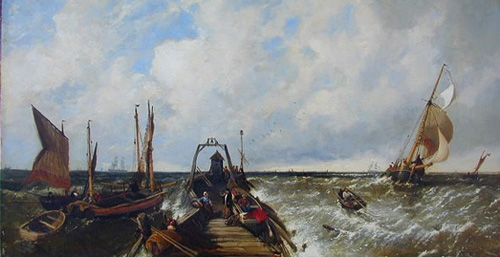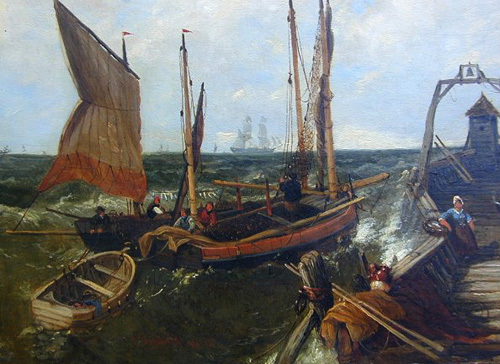Clarkson Frederick Stanfield RA.
Born: Sunderland, December 3
1793.
Died: Hampstead, May 18 1867.
Son of the abolitionist, actor & author
James Field Stanfield.
At 15 he entered the merchant navy but was ‘pressed’ into the
Royal Navy in 1812 under the alias ‘Roderick Bland’. Discharged,
following a rigging accident, which left him lame, he sailed on
a merchant ship to China in 1815. Upon return and being unable
to find work, he took up theatre scenery painting in London & Edinburgh;
whilst in the latter city he formed a life long friendship with
David Roberts who was similarly employed at that time.
In London he met the 24 year old, Charles
Dickens, whilst creating
scenery for his private theatricals at Tavistock
House, they also
formed an enduring friendship. Indeed, Dickens was one of Stanfield’s
last visitors on the day of his death.
His first wife, Mary, gave him two children and following her
death in 1821 his second, Rebecca, gave him 10. Their second son
George Clarkson Stanfield (1828-1878) also became a successful
painter.
Graduating from scenery painting, Clarkson Stanfield concentrated
on marine, coastal and river subjects of which he had much first
hand experience, having filled numerous sketchbooks whilst on board
ship.
By 1820 he was being recognized as a painter having great promise.
he later became known as ‘the English Van De Velde’. He was a founding
member of Society of British Artists - Suffolk Street (1823) becoming
its President in 1829, the same year he began to exhibit in the
Royal Academy.
He was elected an Associate in 1832, and RA. member 1835, he continued
to exhibit there and the British Institute until 1867. He was commissioned
by King William IV to paint the Opening of the New London Bridge
(1831), Portsmouth Harbour and the Battle of Trafalgar (1863) the
latter still in the possession of the United Services Club Pall
Mall, also HMS. Victory with the Body of Nelson on Board being
towed into Gibraltar (1805) are among his best known works, many
of which were engraved.
In later life he was known as a slightly portly, jolly man who
lived and loved life to the full, despite the pain to his foot
resulting from the accident with an anchor. He was considered a
good humoured listener and excellent company, provided the subject
of religion was avoided. The sudden death of David Roberts affected
him greatly and brought sadness to his closing years whence he
remained secluded but busy.
NAT GALL. (LOND). V & A. GARRICK. RA.






